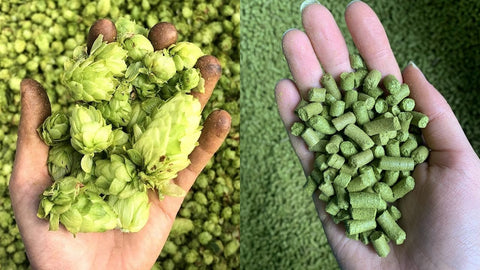
What is a microbrewery?
Guide to microbreweries
The trend to stay away from the big commercial brewers is growing. More people are looking for local beers brewed in small-sized breweries. Small breweries add a personal touch to their products and have interesting stories behind them. Thus, when people buy their beers, often they look at the brewery where it comes from. Small breweries give the consumers more variety and an opportunity to discover something new.
In this article, we will cover some of the topics on beer and microbreweries:
- What is a microbrewery?
- History of microbreweries
- How does a microbrewery work?
- How to open a microbrewery?
- Microbreweries around the world
- Difference between a craft beer brewery and a microbrewery
What exactly is a microbrewery?
Microbrewery, which some people also refer to as craft beer brewery, is a term used to describe the size of the brewery. Generally, a microbrewery is considered to be a brewery that produces between 1000 to 15000 barrels of beer annually. This benchmark can vary slightly by country.
Besides microbrewery, other terms are used to describe the size of breweries. Macro, nano, pico or craft brewery are also used to classify a brewery.

History of microbreweries
In the late 1970s in England, came a new generation of small breweries. Thus, there was a need for a new term, and people started using the word microbrewery. This word has now spread around Europe, the United States and many other places around the world. In Belgium and France, the word craft beer brewery is more commonly used, where craft beer has been produced for centuries.
The term microbrewery does not only refer to the size of the brewery. The term comes with an attitude. Microbreweries generally focus on brewing more experimental and consumer-oriented beers. The small breweries often want to refer to their local region or area.
The generation of microbreweries has also shown a lot of creativity. Thus, we can see beers on the market with seaweed, hemp or buckwheat. Many microbreweries also produce seasonal beers for a short period. This takes people on a journey of tastes.
How does a microbrewery work?
It is not complicated to understand how a microbrewery works. What a craft beer brewer needs are the equipment, ingredients and a place for brewing. Any micro brewery works the same way as a big brewery, just on a much smaller scale. Once the brewer has all the ingredients, the machines will take care of the rest. The brewers just need to follow the steps of making a beer and then can start their business.
How to open a microbrewery?
If you are interested in opening your microbrewery, you should consider certain steps. First, you should do some research about the market. This will give you a better idea of what is already available and what you could do. You can find opportunities to make yourself stand out from the crowd. Don’t forget that the brewing industry has grown a lot, so there is a lot of competition.
Once the research is done, you can start putting together a business plan. You will need to choose a location that fits your brewing plans. And as an amateur brewer, you need to be sure you have all the financial means to support your project. Don’t forget to add all the details to your business plan, like the local rules and regulations, the legal status and the licence you need and other administrative requirements. Finally, when your plan is ready, you can share the news or find a partner to help you realise your dream.
Microbreweries around the world
In recent years, the popularity of microbreweries has grown all around the world.
Belgium, with a rich beer history, started to see the phenomen and the term microbreweries coming to the surface in 1980. The small breweries then focused more on specialty beers, but slowly wilder and more unique beers came on the market. The Belgian microbreweries are benefiting from the high Belgian beer international reputation and the fact that consumers everywhere have started to look for smaller brewers.
Read also: The best Belgian microbreweries.
In Europe, the term originated in the United Kingdom, but many other countries already had established microbreweries. For instance, there are microbreweries in Germany that have been brewing traditionally for hundreds of years. Sweden and Norway established their first microbreweries in the late 80s and 90s. Other European countries followed much later, but with a big bang. In Italy, for instance, there are more than 900 microbreweries. Even countries with a small population have seen a big boom. For example, Estonia has established over 30 microbreweries with a population of only 1.3 million people.
Read also : The best French microbreweries.
In North America, the craft beer movement already started in the late 20th century. In Canada, the first microbrewery opened in 1981. When the beer market was deregulated in 1979 in the United States, microbreweries and home brewing became very popular. In Mexico, craft beer became popular in the 90s, but it is mostly exported to the United States.
In Asia, the trend has grown too. For instance, Cambodia opened their first microbrewery in 2009. China is one of the largest beer consumers, and the interest in craft beer started to take off in 2013. Even a small island in Sri Lanka, despite the strict laws, has managed to open and maintain a small brewpub. Vietnam takes the title of the largest craft beer producer in South East Asia, which has over 30 microbreweries.
Even the Middle East does not fall behind. Craft beer brands have become very popular in Turkey. Also, Jordan established their first microbrewery in 2010.
What is the difference between a craft beer brewery and a microbrewery?
Many people connect craft beer breweries and microbreweries, thinking these words are synonyms. There are some differences here. The definition of a microbrewery is set by the number of barrels of beers produced in a year. A craft beer brewery has set a limitation to the brewing techniques they use. The confusion is easy to make as a microbrewery can produce craft beers. Thus, a microbrewery can be a craft beer brewery if it follows the standards. A craft beer brewery is not always a microbrewery as the brewery sizes for craft beer vary.
So, what kind of beer drinker are you? Do you pay attention to the small brewers when buying your beers?



Leave a comment